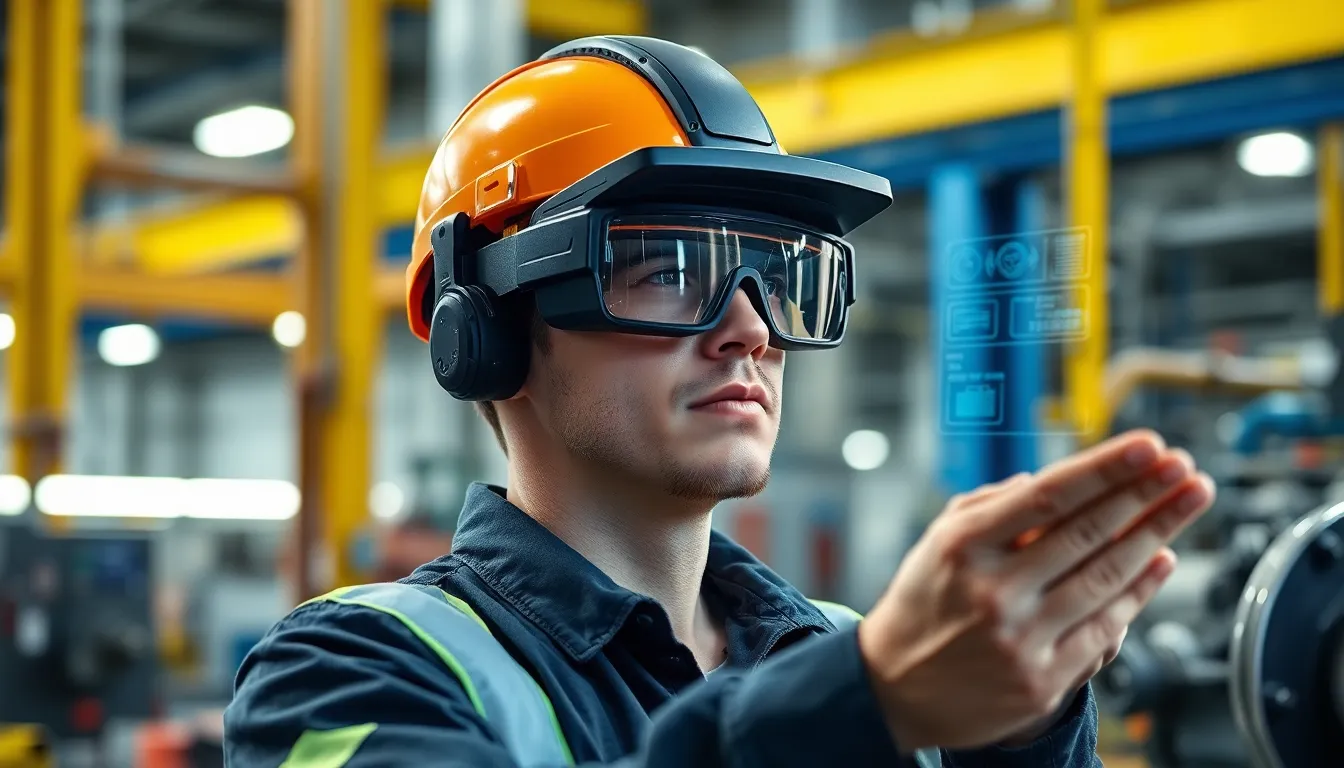Imagine walking through your living room and suddenly seeing a dinosaur strut by your coffee table. That’s not a scene from a sci-fi movie; it’s the magic of augmented reality (AR) technology. With a sprinkle of digital flair, AR transforms the ordinary into the extraordinary, blending the virtual world with our everyday lives.
Table of Contents
ToggleOverview of AR Technology
AR technology integrates virtual elements into the real world, enhancing the user’s environment with interactive experiences. This technology overlays digital content on the physical world, facilitating a seamless interaction that enriches daily activities. Users access AR through devices like smartphones, tablets, and smart glasses, allowing for widespread adoption in various fields.
Gaming represents one of the most popular applications of AR. Games like Pokémon Go illustrate how players engage with their surroundings while catching virtual creatures. In advertising, brands utilize AR to create immersive campaigns that captivate consumers. Retailers leverage this technology to provide virtual try-ons, improving the shopping experience significantly.
Education benefits from AR by offering interactive learning opportunities. Students visualize complex subjects through AR applications, enhancing comprehension and retention. Healthcare professionals use AR for surgical training, providing realistic simulations that prepare them for real-life procedures.
Furthermore, AR finds applications in architecture and design. Architects visualize their projects in real-time, aiding in presentations and client consultations. By merging physical and digital elements, AR streamlines the design process and fosters collaboration.
Market research indicates that the AR sector is rapidly growing. According to Statista, the global AR market is anticipated to reach approximately USD 198 billion by 2025. As industries continue to explore AR’s capabilities, its impact on communication, design, and consumer interaction will expand, redefining how people engage with their environments.
Applications of AR Technology

AR technology finds applications across various sectors, enhancing functionality and user engagement.
Industrial Uses
In industrial settings, AR streamlines operations by providing real-time data overlays. Workers utilize AR glasses to access important information hands-free, improving safety and efficiency. Maintenance procedures become more effective with visual aids that guide technicians through complex tasks. Additionally, design and prototyping benefit from AR simulations, allowing teams to visualize equipment and products before manufacturing. In logistics, AR assists with inventory management, enhancing accuracy and reducing errors during stock-taking.
Educational Uses
Education embraces AR to create engaging learning experiences. Students interact with 3D models that offer deeper insights into complex concepts like anatomy or physics. Teachers leverage AR apps for interactive lessons that capture attention and foster collaboration. Virtual field trips expand classroom boundaries, allowing learners to explore distant locations without leaving their seats. AR tools empower educators to customize learning materials, catering to different learning preferences and enhancing knowledge retention.
Entertainment Uses
Gaming embodies one of the most notable uses of AR. Players immerse themselves in alternate realities that blend with their surroundings, creating unique gameplay experiences. Popular games like Pokémon Go encourage exploration by integrating the real world into their narratives. Theme parks utilize AR for enhanced attractions that leave lasting impressions on visitors. Furthermore, AR applications in storytelling provide innovative ways to deliver content, allowing audiences to engage actively with their favorite characters and plots.
Benefits of AR Technology
AR technology offers numerous advantages across various sectors. Enhanced user engagement stands out as a primary benefit. Users interact with their environments while exploring virtual elements, leading to immersive experiences that capture attention.
In education, AR fosters deeper understanding. Interactive 3D models and virtual field trips allow students to visualize complex subjects practically. Engagement increases, making learning more appealing and effective.
Healthcare professionals gain from AR applications as well. Surgical training simulations provide realistic environments for practice. Such technology improves skill acquisition and boosts confidence during actual procedures.
Retailers also see significant advantages. Virtual try-ons enhance the shopping experience, allowing customers to visualize products before purchase. This immersive approach reduces returns, ultimately benefiting both consumers and businesses.
In the gaming industry, AR transforms how players interact with their surroundings. Games like Pokémon Go encourage outdoor exploration, merging physical locations with digital adventures. Player engagement rises as a result, driving industry growth.
Marketing campaigns utilize AR for increased customer fascination. Brands create immersive advertisements that capture attention, leading to higher conversion rates. Consumers experience deeper connections with products, enhancing brand loyalty.
In design and architecture, AR simplifies visualizing projects. Architects can display models in real time, streamlining collaboration and decision-making processes. Enhanced visualization helps mitigate miscommunication and refines project outcomes.
Manufacturing and logistics sectors improve operational efficiency thanks to AR. Providing real-time data overlays aids in maintenance and inventory management. Workers benefit from clearer instructions, minimizing errors and enhancing safety.
Overall, AR technology continues to redefine interactions across multiple domains. It enhances functionality while ensuring engaging experiences. As the global AR market approaches USD 198 billion by 2025, its impacts will expand, shaping future communication and consumer behavior.
Challenges in Implementing AR Technology
Implementing AR technology presents several challenges that hinder its widespread adoption. High development costs deter many businesses from pursuing AR solutions. Investing in technology demands significant resources, which can be prohibitive.
Technical limitations also pose issues. Device compatibility issues arise due to the varying capabilities of smartphones, tablets, and smart glasses. Users expect seamless experiences, which can be difficult to achieve across different platforms.
User experience plays a critical role in AR adoption. If not well-designed, applications risk confusing or frustrating users instead of enhancing their interactions. Clear and intuitive interfaces are essential to promote engagement.
Privacy concerns have emerged as a notable challenge. Users worry about data collection and security. Companies must navigate regulations while ensuring user trust is maintained.
Training and adoption processes require careful planning. Employees must learn how to effectively use AR tools, necessitating time and resources for training programs. Resistance to change can further complicate this transition.
Market saturation in certain areas also limits growth opportunities. The novelty of AR technology may fade if consumers perceive it as just another trend. Continuous innovation is vital to keep user interest alive.
Integration with existing systems often proves complex. Businesses may find it challenging to incorporate AR tools into their current workflows and technologies. A clear strategy is essential for successful integration.
Addressing these challenges is crucial for organizations that aim to leverage AR technology for enhanced user engagement and experience. Companies need to prioritize solutions that mitigate these obstacles to fully harness the potential of AR.
Future Trends in AR Technology
In the coming years, AR technology is expected to see significant advancements, driving broader adoption across industries. Enhanced hardware, including lightweight smart glasses, will make AR experiences more accessible. Devices will integrate seamlessly with daily tasks, allowing users to engage with virtual elements as they go about their routines.
Collaboration tools will also evolve, enabling remote teams to work together in AR environments. Interactive meetings and shared projects will enhance productivity and creativity among participants. Users can visualize concepts in real-time, fostering innovative problem-solving.
Education will witness a revolution in learning methodologies. Personalized AR experiences will cater to individual learning styles, making education more effective. Skills acquisition in technical fields will improve through AR simulations, providing hands-on training without the associated risks.
Healthcare practices will continue adopting AR for enhanced patient care. Surgical procedures may become more precise through real-time imaging, leading to improved outcomes. Enhancing training programs with AR will equip medical professionals with practical experience.
In retail, brands will leverage AR to create immersive shopping experiences. Virtual try-on features will enable customers to visualize products before purchasing, reducing return rates. Shopping will become more interactive, blending the joys of exploration and convenience.
Challenges related to privacy and data security will prevail, necessitating careful navigation by businesses. Designers will prioritize user-friendly interfaces to ensure satisfaction and engagement. Standardization across devices will improve compatibility, easing the path for widespread AR integration.
Finally, market forecasts indicate the global AR market approaching USD 198 billion by 2025. Companies will need to focus on developing solutions that overcome existing barriers. Embracing these future trends will facilitate the expansion of AR technology, reshaping how individuals and organizations interact with their environments.
AR technology stands at the forefront of innovation transforming various industries. Its ability to blend the virtual and real worlds opens up endless possibilities for enhanced user experiences. From gaming to education and healthcare, AR is reshaping how individuals interact with their environments.
While challenges like high development costs and privacy concerns remain, the potential benefits far outweigh these obstacles. As advancements continue to emerge, businesses that embrace AR technology will likely lead the way in creating engaging and immersive experiences.
The future of AR is bright and filled with opportunities for those ready to adapt and innovate. It promises to redefine interactions in everyday life, making the extraordinary accessible to everyone.



